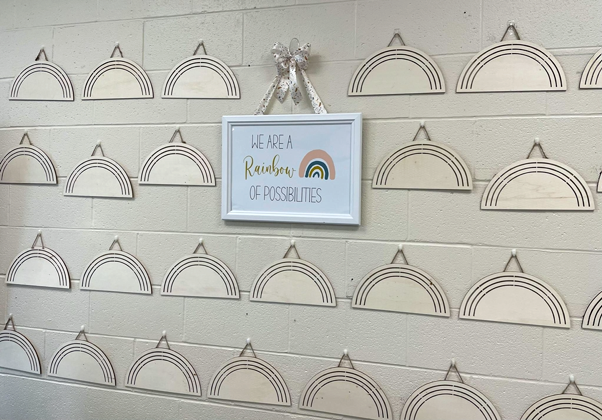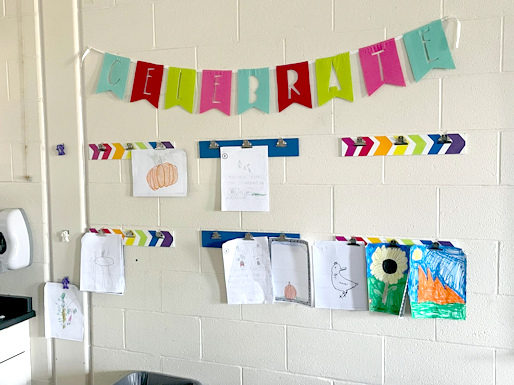Classrooms tell a story. A story about who the students and teacher are, what they value, and what they are learning or will be learning—a story that includes their collective hopes and goals for the year. Classrooms are special spaces where friendships are developed, skills are honed, and strong communities are built. Classrooms are remarkable environments that hold great power. When we think about setting up a classroom space it is important to remember the unique social-emotional needs of the students we work with and how we can use elements of classroom design and organization to create optimal learning environments where all students thrive. As you design, grow, and manage your classroom space during the school year, consider the following guidelines.
Welcome All Children
In any given classroom there are students with diverse needs, interests, cultures, abilities, and experiences. The variety of students in a classroom can be compared to flowers in a flowerbed. Each flower has different needs in order to grow: Some need full sun and others need shade. Some need to be watered often and others can go longer between waterings. Flowers bloom at different times and grow to be different sizes. Some flowers bloom in the spring and others bloom months later. Following this analogy, we can see that students’ range of abilities and daily needs are expressed in many different ways, and we as educators need to use developmentally appropriate strategies to support their growth and development in all areas. What flowers and students have in common is that they both require a supportive environment, an in-tune “garden” capable of addressing the needs of each “flower.”
As we set up our own “garden bed,” it is important to take steps so that the classroom will welcome and represent all students:
- Ensure you have a space in which to hold a daily Morning Meeting and closing circle, which will support building a class community.
- Offer a variety of displays, books, and other materials that honor students’ cultures, family structures, and abilities.
- Take into account students’ developmental needs.
Support Diverse Developmental Levels and Learning Styles
Students thrive in environments that are in tune with their social-emotional and developmental needs, and they prosper in spaces that meet those needs as they change throughout the school year. Teachers can anticipate the social-emotional and developmental needs of students based on child and adolescent development research, such as Chip Wood’s Yardsticks (2017). Teachers can also obtain useful information by observing students as they navigate the classroom space, interact with that space, and use it as an additional support for their learning. Throughout the school year, educators should plan time to consistently observe students in order to consider what adjustments might be needed to the space so that it can continue to support students.
As you reexamine your school space, taking into account the overarching social-emotional and developmental needs of your students, reflect on the following guiding questions:
- What are the developmental needs of the students in this space at the beginning of the year, middle of the year, and end of the year?
- What social and emotional skills will students develop this year?
- How will this space honor the development of those skills throughout the year?
A few years ago I looped back with the students I taught in first grade to teach the same group in second grade. As I prepared for the year and set up the physical space, I used the same flexible seating options as I had used when those students were in first grade. We had crate seats, scoop seats, rocking chairs, and wobble stools. At the beginning of the year those flexible seating options worked really well for us. Students were familiar with the flexible seating options and needed minimal refreshers on their use in the classroom.
As the first trimester came to a close, students began physically growing out of some of the flexible seating choices and had difficulty using them during learning times. The tops of the crate seats began to crack and break, and the children’s knees were up to their chins when they attempted to use the scoop seats. They were officially too big for their beloved first grade seating choices, and those particular seating options no longer met students’ physical needs. As the trimester came to close, I restructured the space and brought in other options that students would enjoy while I tucked away the scoop seats and crate seats. Although as teachers we know that children will change physically throughout the year, and sometimes seemingly overnight, the many everyday demands we face sometimes prevent us from noticing those changes. Continually observing students’ interactions with their environment and reflecting on those observations can keep us aware of how our students are developing and help guide any changes you might make to the physical space.
Continually observing students’ interactions with their environment and reflecting on those observations can keep us aware of how our students are developing and help guide any changes you might make to the physical space.
Value Everyone’s Ideas and Work

teacher created but turned student created once
students articulated their hopes and dreams and
decorated their own rainbows.
Classroom walls and displays offer opportunities to showcase student learning. At the beginning of the year, the items displayed in the classroom might be teacher created. As the year progresses, the goal should be to replace those items with student work and co-created displays. When students have opportunities to showcase their efforts and add to or collaborate to create important classroom displays, they begin to take ownership of the classroom space. The space begins to transform from the teacher’s classroom, originally filled with teacher-created materials, to our classroom, a space filled with student-created displays and work samples.
As you plan your classroom display, consider the following suggestions for incorporating student contributions:
- Display work in all phases of the work process (beginning, middle, end product).
- Celebrate and honor effort.
- Balance teacher-created charts, posters, and displays with student-created items.
- Work with students to make displays such as word walls, sound walls, classroom labels, or a birthday bulletin board.
(For more ideas about how to incorporate student work in your classroom displays, see Howard et al.’s Empowering Educators: A Comprehensive Guide to Teaching Grades K, 1, 2 [2021].)
Create a Celebration Wall

Honoring student work in all stages of the process further builds the classroom community and supports students in celebrating their work and the efforts of their classmates. Consider having a space where students can display their work at any stage in the process. Students might display a picture they drew, a draft of a story, a math worksheet they completed, or another piece of work that they are proud of and want to share with others.
Support Active and Engaged Learning
The classroom setup offers another opportunity for supporting student engagement and active learn- ing. When placing furniture, check to be sure that students will be able to move around the classroom with ease, and remove any barriers that might pre- vent all students from easily navigating the space. Looking at the classroom developmentally, we want it to support the ways in which students at each grade level work and collaborate. Offering areas where children can work alone, in partners, in groups, and as a whole group honors various grouping structures that support student learning.
To support active learning as you consider your classroom space, keep in mind the following:
- Less is more. Rotate anchor charts and accessible materials based on the needs of students and to avoid too much clutter.
- Be flexible and open to rearranging furniture based on function as students experience the space.
- Place furniture to allow for ease of movement throughout the classroom. (This is especially important when using interactive learning structures and energizers.)
- Use flexible furniture and/or flexible seating options that meet a variety of student needs.
Foster Independence, Responsibility, and Cooperation
As you consider the specific tools and materials students will have access to throughout the school year, two important strategies for supporting students in appropriate use of these tools and materials are Interactive Modeling and Guided Discovery (Center for Responsive Schools, 2020). Interactive Modeling is a practice that allows all students to better understand the expectations around the use of certain tools and materials, while Guided Discovery allows students to think creatively about the use of classroom tools and materials. Both practices support students in developing independence, responsibility, and cooperation.
Download Interactive Modeling and Guided Discovery Planning Guides here.
Such materials should be clearly labeled and placed in areas that are easily accessible for students. Consider what materials students gravitate toward at different times of the school year and what tools and materials support the learning that is happening. In addition, think about how you will rotate tools and materials based on what students need at that time of the year. For example, you might begin the school year with a choice of a few art materials for use during the day and add more complex materials that require additional practice and care later on in the school year.
Here are some ideas to consider for supporting student use of classroom tools and materials:
- Make sure class tools, materials, and displays are current and align with student needs.
- Provide a variety of learning materials for students to draw from during the day.
- Clearly label and place materials in areas that are easily accessible for all students.
Think About Your Own Needs Too!
Many teachers spend eight hours a day (and often more!) at school and a significant amount of that time in the classroom. The amount of time spent in a classroom on any given day frequently exceeds the amount of time some of us spend outside of the classroom, especially during particularly busy times of the school year. With that in mind, remember to consider your own needs and what that might look like for you in the classroom space. For me, this looks like a big velvet pink chair for comfort when I have a rare moment to sit down, a special coffee maker for my morning cup of coffee and occasional afternoon pick-me-up, and pictures of my family that evoke happiness and smiles.
What brings you comfort, joy, and happiness? We spend a lot of time considering the needs of students and how the classroom space supports those needs, but remember, your needs are important and the classroom space should honor your needs in the space too.
The Classroom Space Is Always Evolving
The classroom space, just like our students, is constantly changing and evolving each and every day. Our classroom is not a stagnant area, but rather it is a living and ever-changing support for our community. Classroom spaces aid student development and honor their unique needs as they grow and change during a school year. When we create classrooms with students’ needs at the forefront of our thought and keep our own needs in mind, we can create optimal learning environments that meet the needs of all members of the classroom community and ultimately have a significant impact on student success.
See article references here.

Becky Wanless-Bobo
Becky Wanless-Bobo currently teaches first grade near Columbus, Ohio, at New Albany Plain Local Schools and has worked as an educator since 2005. She earned two master’s degrees from The Ohio State University and is an educational coach and consultant for Center for Responsive Schools. Becky developed a passion for the Responsive Classroom approach after attending a workshop and then seeing the positive impact this approach had with students and staff. Becky is the co-author of Empowering Educators: A Comprehensive Guide to Teaching Grades K, 1, 2.
